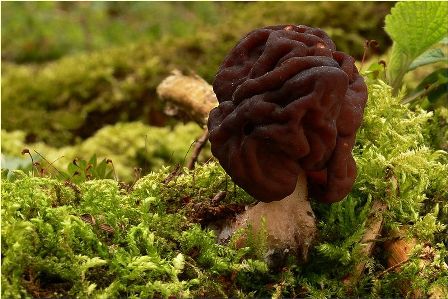Toxicity
Gyromitra esculenta is a little confusing when it comes to its ability to poison people. Some people have eaten it and not felt any adverse effects; others have died soon after ingestion. No one has figured out why it affects different people differently, but it is known that environmental factors play a huge role. In fact, Gyromitra esculenta has relatively high concentrations of gyromitrin compared to other Gyromitra species. The concentration of toxin varies even within the species because of variable climate, nutrition, water availability, etc. There’s no way (yet, check when this site was updated) to know if a false morel contains enough toxin to kill you. The lethal dose is 20-50mg/kg in adults and 10-30mg/kg in children. So if you are going to roll the dice and eat these things, just be aware that it could go either way.

The name of the toxin is
gyromitrin. The 3D structure is shown above.
(grey-carbon, white-hydrogen, blue-nitrogen, red-oxygen)
When it was discovered that the false morel was poisonous, however, people thought it was hellvellic acid.
Gyromitrin contains small amounts of
N-methyl-N-formyl hydrazine. The structure of that
compound is remarkably similar to rocket fuel. The compound
derived from hydrazine has been shown to act as a powerful
carcinogen. When its effect was tested on
mice, they grew tumors over their lifetime. (Leathem,
2007)
Hydrazine prevents enzyme activation of pyridoxine, also known
as vitamin B6.
This causes the body to not be able to break down food,
and increases susceptibility to seizures.
Hydrazine is also irritating to mucous membranes and the
digestive tract. Symptoms show up 6 to 12
hours after ingestion. They include a bloated
feeling, nausea, vomiting, diarrhea, muscle cramps, and, in
severe cases, seizures and death.

Fluid and electrolyte
imbalance is the most common complication of gyromitrin
poisoning, as well as seizures. If the
patient can be kept hydrated and nourished they have a better
chance of recovery. Also, administering
vitamin B6 has been recommended in serious cases.
Decontamination usually isn’t necessary because people
don’t seek treatment until two to six hours after being
poisoned.
By that time, people have been vomiting and most of the
toxin is gone. However, a single dose of
charcoal (right) is a treatment mode.
Feeling lucky?

If you still aren’t deterred from eating these mushrooms, you should know a couple of facts about cooking them. In theory, the toxin can be boiled off, but some may remain in the water. Hydrazine is volatile, so it could evaporate. Therefore, the person cooking it could inhale the toxin and be in more danger than people eating it! Drying them before cooking can reduce the toxin concentration. Cooking them by drying and rehydrating or boiling, rinsing, and boiling again can also help reduce the risk. Still, it is never certain all the toxin will have been cooked off, and I don’t recommend taking that chance.
Now that you’ve read about the darker side
of Gyromitra esculenta, visit the
fun facts
page for some interesting tidbits of information about this
fascinating mushroom.

photo source:
blogspot.com
All other photos on this page came from Wikipedia.com.

